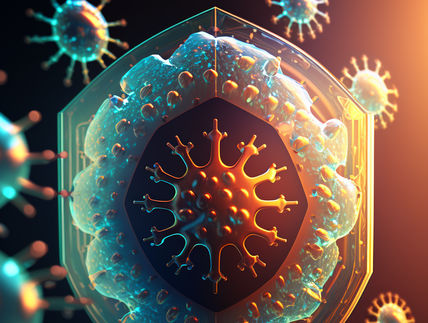Revealing the Invisible Enemy
The coronavirus model developed by the Coronavirus Structural Task Force is the most exact model developed in the world to date
Advertisement
Fighting the coronavirus has changed the way the international scientific community works together and intensified collaboration. Dr. Andrea Thorn leads an international research group at Universität Hamburg that is improving molecular models from across the world to enable the development of pharmaceuticals. The May issue of the Nature Structural & Molecular Biology journal reports on the team’s work.

The coronavirus model developed by the Coronavirus Structural Task Force is the most exact model developed in the world to date. It shows, for example, that the virus is not completely round, and shows the random placement of the spikes.
Coronavirus Structural Task Force/K. Nolte und SciStyle.com/ T. Splettstößer
To develop vaccines and new medications for the coronavirus, one must first decipher how it works. This is a task occupying thousands of researchers across the globe. However, models often only show the “virion,” that is, the shape the virus has when it enters the human body, a form which only has 4 protein molecules. Once it has infected a lung cell however, it creates 24 additional protein molecules. Structural biologist Dr. Andrea Thorn is researching how these proteins are constructed, how they manage to cripple the immune system, and convert human cells to “virus factories.”
“These protein molecules are like robots, that gradually take over the host cell. Once we know their structure, we can figure out how they work, and then make a targeted effort to stop them,” she explains. She first put together a team of international researchers to create the Coronavirus Structural Task Force for her research over a year ago. Today, this teams includes 26 researchers from 7 countries, with the group being coordinated from Universität Hamburg.
The team describes its work in the current issue of the scientific journal Nature Structural & Molecular Biology as testing and improving the molecular structures of the virus being measured in experiments across the world. Every week a dozen molecule structures are published in the Protein Data Bank (PDB), a global database founded in 1971 in the USA as the first public and freely accessible digital data source for biology. The research group around Dr. Thorn uses new and existing methods to improve the structures published in that database, with a mixture of automated software, artificial intelligence and manual 3D checking of individual atoms on a computer. “This work is a huge benefit for researchers in pharmaceuticals and virology who then continue working with the structures. They need to have the best possible molecular models. Any mistakes may lead their research in the wrong direction, or mean that a medicine is ineffective,” says Thorn.
The Coronavirus Structural Task Force publishes the results for use by the scientific community on the openly accessible insidecorona.net webpage. They also provide background information, animations, and a model of the coronavirus suitable for 3D printing. This data allows all interested parties to print their own model of the virus: an opportunity particularly taken up by school classes, reports Thorn.
























































